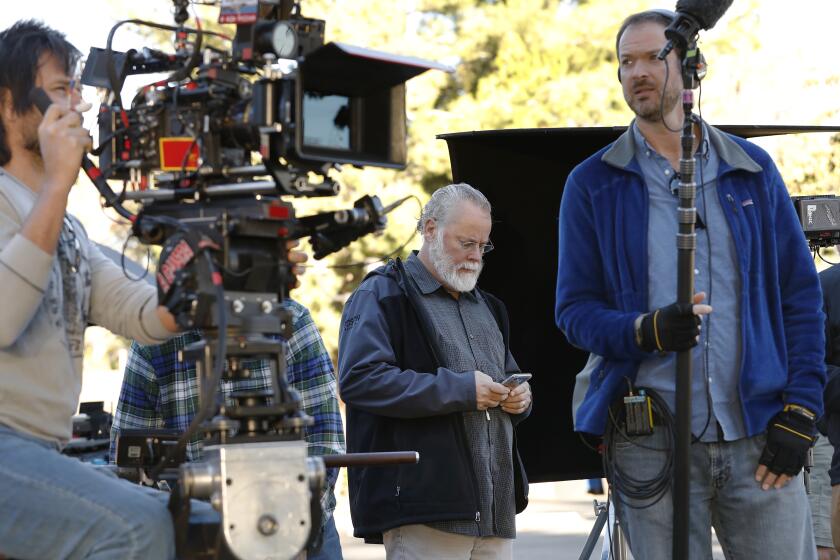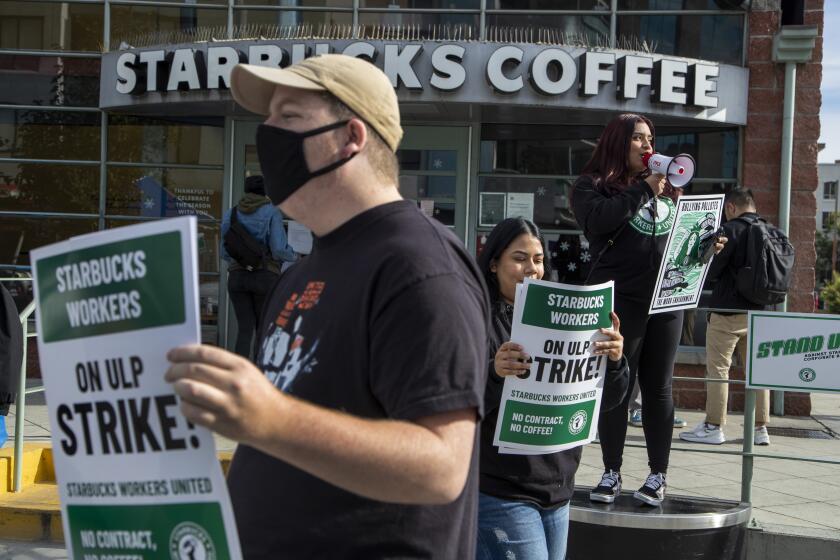Behind the stunning job losses in Hollywood: ‘The audience has moved on’

The iron fist of history seems finally to be coming for Tinseltown.
Beyond the financial blows inflicted by the pandemic and the actors’ and writers’ strikes, the vast Los Angeles-based entertainment industry known as Hollywood is facing the far greater forces of economic disruption that have already struck the rest of the United States.
Much like manufacturing, agriculture and other major segments of the U.S. economy before it, the result for Hollywood appears to be mixed: a possible return to prosperity and good times for some, ever tighter times for others.
“There is something of an existential question mark over large swaths of the traditional Hollywood economy,” said Stuart Ford, chairman and chief executive of Los Angeles-based AGC Studios, which develops, produces, finances and licenses films and television series.

Subscribers get exclusive access to this story
We’re offering L.A. Times subscribers special access to our best journalism. Thank you for your support.
Explore more Subscriber Exclusive content.
The decades-long way of making money in the film and TV industry has been turned upside down by new technologies, changing public appetites and the globalization of the workforce.
“The key thing here is that you have so many of these things happening at once that it’s really hard for anybody to feel confident,” said Kevin Klowden, an economics expert at the Milken Institute who has done extensive research on California’s entertainment industry.
Studios and workers alike were eager to restart film and TV production after the Hollywood strikes concluded. What’s taking so long in California?
“There’s a very, very real question right now on the business side that’s playing out, because nobody’s quite sure of the economics.”
What is clear is that the numbers are bleak — for box office receipts, filming activity and especially employment.
Coming out of the strikes in the fall, many expected a rebound in local film and TV jobs. But employment in L.A. County’s motion pictures and sound recording industries — the main category for film and television production — has barely budged from about 100,000 through April, which is about 20% less than pre-pandemic levels. Aside from the early months of COVID-19 in 2020 and the strikes in the summer last year, employment in the sector hasn’t been this low in more than 30 years, according to the U.S. Bureau of Labor Statistics.
The effect on lost wages and purchasing power is significant for the regional economy. Employees in the motion pictures and sound recording industries earned on average $2,600 a week last year, making up in total about 5% of L.A. County’s wages in the private sector, although less than 3% of employment.
And there are tens of thousands more people in Southern California who work for Hollywood as freelancers and contractors but aren’t counted in government payroll data. Taken together, they make up the biggest concentration of entertainment industry workers in the world and are part of the explanation of why California’s overall labor market is lagging behind the nation’s.
What’s disrupting the future for entertainment industry workers is much like what began convulsing U.S. manufacturing decades ago: new technology that has transformed the business and reduced the need for workers, as well as the rise of cheaper production sites elsewhere in the U.S. and abroad.
Even before the strikes, studios had already dramatically cut back on spending on new shows after the so-called streaming wars — when companies lavished huge amounts of money on direct-to-digital content to compete with Netflix.
Globally, film and TV production lagged by about 7% in the first quarter of 2024 compared with the same period in 2023, according to tracking company ProdPro.
Los Angeles probably will remain a thriving center for those who work at the top of the film and TV industry, but much of the production and distribution work may continue to move elsewhere.
Toronto, for example, has long been an attractive alternative location for shooting movies, while the streets of New York are widely used for television. In recent years, a host of other locations including Atlanta have begun cutting into L.A.’s share of the business.
In fact, outside L.A., the film and TV industry’s payrolls nationally have largely recovered, reflecting in part California’s high costs and the long-term outflow of production to other locales, including Atlanta, Vancouver and London.
California’s share of U.S. employment in motion pictures and sound recording is now down to less than 30%, from almost 40% just a decade ago.
New York is doubling down on film and TV to compete with its main rival, L.A., for a bigger slice of the Hollywood pie — even as the industry is struggling to rebound.
The economic ripple effects are being felt across the region, including by prop manufacturers, design studios, talent agencies and the scores of caterers and ancillary businesses serving Hollywood.
“I feel like I’m starting my business all over again,” said Ryan Johnson, president of NewRuleFX, a special effects prop maker in Van Nuys who has been in the industry since the early 1990s. With demand slacking for such products as fake blood, rubber glass and breakaway furniture, Johnson said he has had to tap all his loan and credit lines on multiple occasions to pay his seven employees.
Some so-called below-the-line crew members — that includes boom operators, costume designers and camera operators — are going back to school and rewriting their résumés to try their luck in different fields such as manufacturing, engineering and business services.
The world also looks topsy-turvy in the offices of studio executives and for the so-called showrunners who call the shots on television series. Amid waves of consolidation and reorganization, partly in reaction to the rise of Netflix, YouTube, TikTok and other internet video platforms, legacy film studios are all asking the same questions: What can we do to win back today’s audience and how can we make money when the old business model has faded?
On top of budget pressures of much higher borrowing costs, the traditional way of doing “gap” financing, which involves borrowing against future revenue from unsold distribution rights — a longtime part of the independent film and TV model — is now prohibitively expensive, said Ford of AGC Studios.
Private equity partners and even once-enamored Chinese investors, all previously drawn by the limelight of the entertainment industry, have become scarce.
And nobody seems sure about the long-term viability of Hollywood’s bread and butter — the feature film made for the big screen.
Film and TV writers of varying experience levels are struggling to find work after the Hollywood strikes amid an ongoing industry contraction.
Is this time really different?
Nothing comes close to the breadth and depth of the industry’s economic crisis today except what happened in the early 1950s, another period of technological upheaval when television became ubiquitous in American homes. Television hit as federal antitrust lawsuits broke up studios’ control over theaters.
By the end of that decade, movie attendance had fallen by more than half from its peak in 1948, when some 90 million Americans, about two-thirds of the population, went to the movies every week, according to author Edward Jay Epstein in his book “The Hollywood Economist.”
In that crisis, Hollywood reinvented its business model: It began producing television programs. And that opened up a whole new way of making money: producing made-for-TV movies and selling rights to reruns, merchandise and, of course, feature films to networks, with distribution to foreign markets as well.
In later years, sales of videotapes and DVDs, as well as licensing deals with cable TV, ensured a steady flow of residual revenues for the studios and key creators and actors.
But what’s different this time is that the threat is coming from multiple fronts.
The extraordinary back-to-back strikes in the summer last year virtually halted production and caused long-lasting disruption to shooting schedules this year and next.
At the same time, the popularity of streaming, led by Netflix, has cut into not only theater attendance and DVD sales but also licensing and reselling revenues that studios long enjoyed. Disney, Paramount and others have joined the streaming bandwagon, but to succeed they need enough long-term subscribers — not so easy when many cancel after watching the particular programs that drew them in.
Analysts have no doubt that traditional studios are still capable of making great movies. The question is whether the public remains interested in watching a 2½-hour feature film inside a theater.
Over the last 15 years Hollywood rode the superhero genre with movies such as “Spider-Man” and the “Avengers” films, but that run appears to be on its last legs — and nothing has come to replace it, said Jonathan Kuntz, a film historian at UCLA. The reaction to last year’s twin blockbusters, “Barbie” and “Oppenheimer,” essentially papered over the industry’s core challenge of exciting the public at the box office.
“The very basis of what made Hollywood universally popular in the 20th century was the theatrical feature film. That seems to be ending now,” Kuntz said. “It seems the audience has moved on to other things.”
Charlie Fink, a former Disney executive who teaches at Chapman University, chalks up the malaise to the fact that “people have other things to do with their screens. They prefer to spend their time on YouTube and play video games on their phones. That’s the problem for Hollywood.”
As U.S. movie attendance has foundered, the international market has grown even more important. But U.S. producers are facing more competition from South Korea, India and other countries producing what’s popular with their audiences at home and beyond.
Nor can major U.S. studios count on the big China market as it had once hoped. Beijing still maintains a strict limit on foreign film showings. Many Chinese are downloading pirated versions of even first-run U.S. movies. And dreams of U.S.-China co-production basically died with the flop of “The Great Wall” in 2016, said Stanley Rosen, an expert on Chinese film and politics at USC.
“It would be great if they had China,” he said. “But you can’t really rely on China.”
The cost factor
With production and budgets scaled back, film and TV producers have been opting for cheaper places to shoot.
Wages matter, of course. But while producers and directors in L.A. on average earn 40% more than those in Atlanta, for example, when it comes to crews, the difference is only about 10% for sound engineers, camera operators and lighting technicians, according to May 2023 figures from the U.S. Bureau of Labor Statistics.
Where there is a bigger gap is in government support for filming. Georgia has no cap on tax credit incentives, which also cover actors’ salaries. Nor does the United Kingdom. And New York state lawmakers last year sharply boosted the annual film tax credit allocation to $700 million — double California’s today.
In most shooting locations outside L.A., the entertainment employment base can still be a limiting factor on production. That’s why people from Southern California are often brought in to supplement and lead local projects, said the Milken Institute’s Klowden.
But not so much these days, he said. “If the productions are cut back, and budgets are trimmed, a major place to see those cuts is in not employing the workers from out of state who need their travel costs covered.”
What worries experts is that as local film industry workers continue to struggle, many will leave the area or quit the business outright because it’s so expensive to build a career and live in Los Angeles.
Employers such as Johnson at NewRuleFX, the prop manufacturer in the Valley, said that after the pandemic waned and business rebounded, many of his employees left the L.A. area due to the high cost of living.
For all the current challenges, one huge advantage that no place has been able to replicate is the vast pool of creative and technical capabilities and infrastructure built up over a century in the area.
“Maybe because there’s a culture in L.A. of people coming here, not just living here, a lot of people who come to partake of their dream,” said Rick Carter, the production designer and art director known for his work on “Jurassic Park” and “Avatar.”
Carter, 74, grew up in the film business — his father was a publicist for Jack Lemmon — and has seen the industry adapt to similar pressures from new technologies and shifting audience tastes.
“If you take all those combustible elements, each one would be itself really tough,” he said of the current climate. “I don’t know whether we’re resilient enough to find a way to move forward.”
Subscriber Exclusive Alert
If you're an L.A. Times subscriber, you can sign up to get alerts about early or entirely exclusive content.
You may occasionally receive promotional content from the Los Angeles Times.
Times staff writer Thomas Suh Lauder contributed to this report.
More to Read
Subscriber Exclusive Alert
If you're an L.A. Times subscriber, you can sign up to get alerts about early or entirely exclusive content.
You may occasionally receive promotional content from the Los Angeles Times.











